Are you in the Training Ghetto?

We talk about change a great deal in our profession of Learning and Development (L&D) – and rightly. There is plenty of change going on at the moment, technological, economic and societal, and we have to adapt to it.
I’m not sure, though, that we think about change in L&D in the right way.
We tend to consider it one-dimensionally, as a straight line – your rate of change is somewhere on a continuum ranging from fast to slow. While this is true, I think it masks the real question: how fast is your L&D team changing in relation to the rate of change of your organisation? This is the question that determines how much impact your work has on your organisation. It may even determine your chances of future professional survival.
There are two axes. The vertical one shows the rate of change of your L&D department, the horizontal one reflects how fast your organisation is changing. I’ve been talking a fair amount this year about change in L&D and whatever country I’ve been in, in whatever sector, this idea of the importance of relative change has struck a chord with the audience. People seem to recognise instantly where they belong.
The top right quadrant is Learning Leadership. If both the department and the organisation are changing fast, this is a great opportunity. We can invest in new procedures and systems, build our skills and experiment with different ways of working with the business, and the business – because it is also changing fast and open to new ideas – will respond. It’s in this quadrant that we find really progressive L&D teams that are making an impact.
While they are undoubtedly leaders, this quadrant is also risky, because that’s the nature of change. The implementation of new technology may not go as planned, a new approach may not find favour with mid-level managers, an unexpected change in the business may mean we have to re-work our learning content immediately. In this quadrant the L&D team has to be open to change and risk, but also willing to tackle any resulting issues fast, and stay in constant touch with the business.
Of course no part of this diagram is free of risk. Diametrically opposed to Learning Leadership is Comfortable Extinction. Here things are pretty much as they’ve always been. The training department produces the same courses, with minor modifications, year after year, and the business accepts them. The department regularly conducts Training Needs Analyses which are no more than asking learners or managers which course they’d like to attend. Level 1 evaluations are conducted after every course, but there is no further analysis of impact, and there is no demand for it from the business. Training is conducted according to what David Wilson calls the ‘conspiracy of convenience’. Everything is quite comfortable until an external change requires the business to change rapidly, it fails to, and the entire organisation, blindsided, goes bust.
The top right corner is home to Instagram, the 12-person company bought for $1bn by Facebook in June 2012. The bottom left is where you’d find Kodak, the inventor of affordable, personal photography, which filed for bankruptcy in January 2012 because it hadn’t changed fast enough.
Sometimes, though, the L&D department is ahead of the organisation it finds itself in. This is where you find those people who rail against their employers’ backwardness, what I call the Unacknowledged Prophets. These departments are often capable of great things, but while their organisations are usually frustrating, they almost always contain a niche where L&D can flourish. Most organisations have at least one manager or executive who gets it, who has a performance need that can be met by learning. Rather than berating the organisation as a whole, find and work with that manager and build a case study of success and a band of positive learners who will spread the word about your work.
If that niche isn’t there, or is too hard to find, there is an alternative: quit and find and employer that does appreciate you.
Most L&D departments that I’ve talked to, however, rightly fear being in the bottom right quadrant, the Training Ghetto. Here, we are unable to service the needs of a rapidly changing organisation. The result: it’s the business, not L&D, that adopts today’s innovative approaches to learning and information sharing. I’ve seen plenty of examples of the sales, operations or marketing departments doing things with wikis, online communities and mobile devices that are fundamentally about learning, but without the L&D department being involved. Why? Sometimes L&D didn’t make their case well enough, but usually it’s just because they were overlooked. In this quadrant L&D is seen as being about training delivery, in the classroom or online, and nothing else. The Training Ghetto is where good information goes to die. It’s the training department that’s in the basement or the Portakabin across the car park. It’s the cost centre that gets cut when times are hard, and which is reluctantly retained for compliance and induction training. It isn’t seen as contributing to the business and the good people there are usually promoted out. Nobody wants to stay in the ghetto.
The question is this: how do we get all L&D departments above that horizontal line and into the top right corner? There are answers, and they are pretty much what I spend my days thinking about. Expect more from me on this subject over the rest of this year, because I don’t believe there’s a more important subject on the L&D agenda.
For now, though, I’d invite you to consider this question: where does your L&D team belong?



